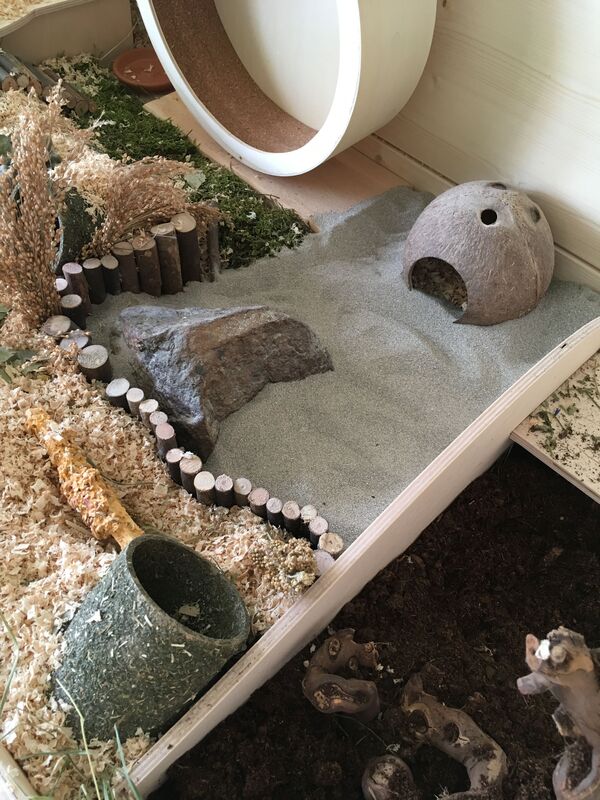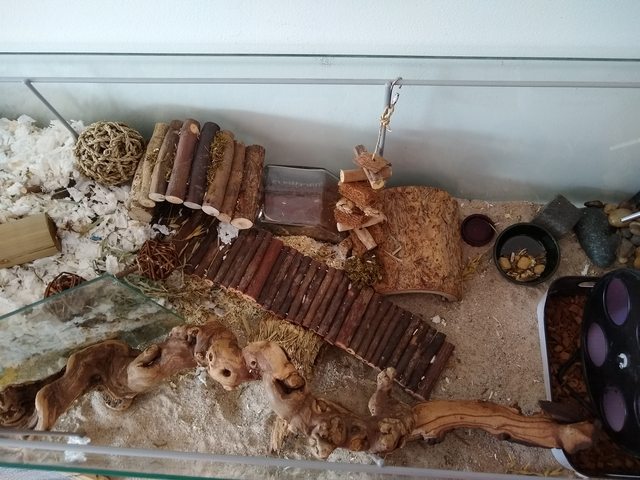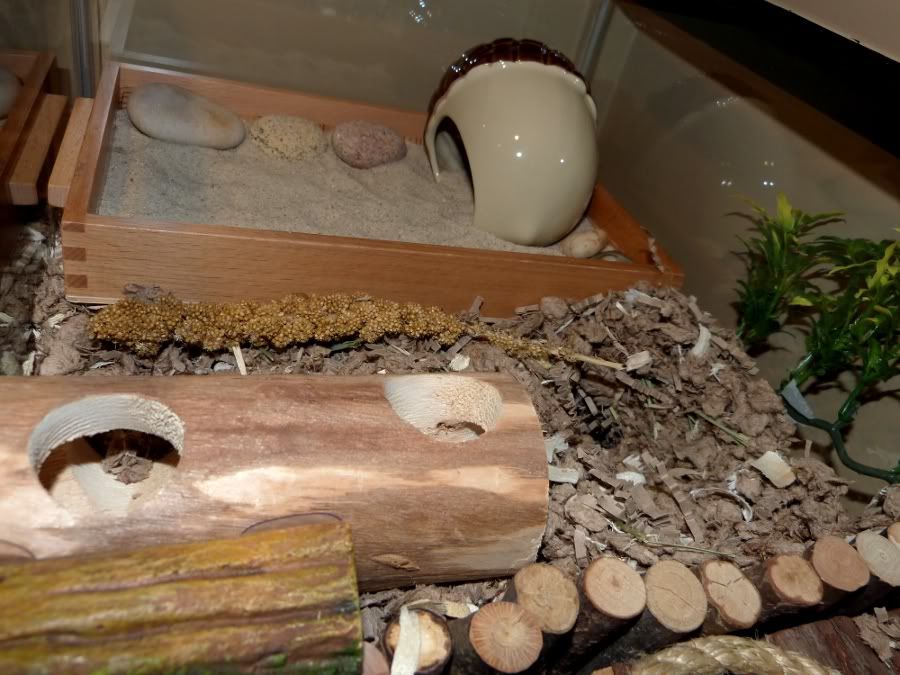General Information:
Roborovskis are a commonly kept dwarf hamster, often referred to as “robos” for short. They’re known for their small size (smallest in their genus) and fast-handling. They originate in central Asia around Mongolia, northern China and northern Russia. They are highly adapted to their environment and live in burrows up to 6ft deep.
In the wild, they’re an omnivorous and social hamster and exhibit crepuscular behaviour.
Their average lifespan is 2-3 years, but ages of up to 4 years have been reported.
Care:
Housing/Enrichment:
Roborovskis are widely considered to be a pet that is difficult to handle, this means their cage will be their main source of entertainment, so your cage must meet the minimum requirements – or larger.
Robos are extremely active rodents and love to burrow. A converted 3ft tank can be ideal for them as it also allows us to provide our pet with plenty of substrates to display their natural behaviour.
We aren’t fans of using barred cages for robos, with them being so small, they can squeeze through very small gaps.
If a tank is not an option, we also enjoy using Duna Multis, Zoozones (you must mesh the lid) or converted bin cages. These cages still provide enough space, and you’re able to provide a decent layer of a substrate. Minimum cage dimensions should be approximately L 80cm x W 50cm.
We use cardboard bedding for respiratory issues for our hamsters, but other great options include fitch, and hemp. We also advise a large bathing sand section to the care, we advise approximately 1/3 of the substrate be bathing sand.
Roborovskis absolutely love to run, so their exercise wheel is one of the most important toys to get right. Suitable wheels should be roughly 20cm in diameter with a solid floor. We use Trixie wheels as they’re more affordable than most pet shop wheels. Robos also love to utilize flying saucers.
You can use a variety of toys for your robo, including tubes, houses, hides, chew toys, dig boxes, sand baths, flower pots, and more.
Temperatures should be roughly 18°C-26°C and humidity around 40%.
Hamsters are permissive hibernators and at temperatures around 4c may enter torpor.
Useful Links:
Roborovskis are a commonly kept dwarf hamster, often referred to as “robos” for short. They’re known for their small size (smallest in their genus) and fast-handling. They originate in central Asia around Mongolia, northern China and northern Russia. They are highly adapted to their environment and live in burrows up to 6ft deep.
In the wild, they’re an omnivorous and social hamster and exhibit crepuscular behaviour.
Their average lifespan is 2-3 years, but ages of up to 4 years have been reported.
Care:
Housing/Enrichment:
Roborovskis are widely considered to be a pet that is difficult to handle, this means their cage will be their main source of entertainment, so your cage must meet the minimum requirements – or larger.
Robos are extremely active rodents and love to burrow. A converted 3ft tank can be ideal for them as it also allows us to provide our pet with plenty of substrates to display their natural behaviour.
We aren’t fans of using barred cages for robos, with them being so small, they can squeeze through very small gaps.
If a tank is not an option, we also enjoy using Duna Multis, Zoozones (you must mesh the lid) or converted bin cages. These cages still provide enough space, and you’re able to provide a decent layer of a substrate. Minimum cage dimensions should be approximately L 80cm x W 50cm.
We use cardboard bedding for respiratory issues for our hamsters, but other great options include fitch, and hemp. We also advise a large bathing sand section to the care, we advise approximately 1/3 of the substrate be bathing sand.
Roborovskis absolutely love to run, so their exercise wheel is one of the most important toys to get right. Suitable wheels should be roughly 20cm in diameter with a solid floor. We use Trixie wheels as they’re more affordable than most pet shop wheels. Robos also love to utilize flying saucers.
You can use a variety of toys for your robo, including tubes, houses, hides, chew toys, dig boxes, sand baths, flower pots, and more.
Temperatures should be roughly 18°C-26°C and humidity around 40%.
Hamsters are permissive hibernators and at temperatures around 4c may enter torpor.
Useful Links:
Socialising:
Roborovskis are social creatures and should ideally be kept in pairs, or more. If a pair or group of roborovskis are fighting, then you should separate them immediately to prevent potentially fatal injuries.
Many people suggest it is simply unfair to keep social species of hamsters in pairs due to the risk of fighting, but we simply disagree. Common claims include "they gain nothing from interaction" - but how was this measured? We haven't come across any literature that holds any weight to that argument. Across many species of rodents who are labelled as social, many would argue it to be a welfare issue if housed alone based on the five freedoms of the Animal Welfare Act 2006 - why are some species of dwarf hamster different? If an owner cannot commit to monitoring a stabilized bond between hamsters and are unaware of antisocial behaviours, perhaps these are not the pet for you.
Roborovskis can be tamed, exactly how much an individual robo tames varies considerably. Consistency is key to taming. We’ve had Robos happy to sit in hands and others who'd absolutely scream the place down when held. Despite that, we’ve rarely been bitten by a Roborovski.
A lot of people prefer to offer their robos a playpen for out-of-the-cage playtimes. We use empty ball pits for our hamsters as it keeps them contained without the risk of squeezing through bars.
Diet:
Roborovski dwarf hamsters are omnivores, meaning they require both plant material and meat elements in their diet. In their natural environment, they’ve been found to eat a variety of seeds and insects.
In captivity, you can provide your dwarf hamster with a good quality hamster mix and healthy treats to keep your hamster well-nourished. Often providing some pelleted foods may be beneficial for hamsters due to their selective eating - overfeeding can help prevent this.
Avoid garlic, onion, and citrus foods.
Useful Links:
Please feel free to ask more questions!
Roborovskis are social creatures and should ideally be kept in pairs, or more. If a pair or group of roborovskis are fighting, then you should separate them immediately to prevent potentially fatal injuries.
Many people suggest it is simply unfair to keep social species of hamsters in pairs due to the risk of fighting, but we simply disagree. Common claims include "they gain nothing from interaction" - but how was this measured? We haven't come across any literature that holds any weight to that argument. Across many species of rodents who are labelled as social, many would argue it to be a welfare issue if housed alone based on the five freedoms of the Animal Welfare Act 2006 - why are some species of dwarf hamster different? If an owner cannot commit to monitoring a stabilized bond between hamsters and are unaware of antisocial behaviours, perhaps these are not the pet for you.
- "Chinese hamsters (Cricetulus griseus) are smaller than golden hamsters and are also solitary.... Russian hamsters (Phodopus sungorus) are slightly larger than the Chinese hamsters and are relatively tame and placid compared with the other dwarf species. Russian hamsters are colonial and can be housed in groups (Figure 1.1), with the males tending to the young." - Sayers and Smith, 2010 (BSAVA Manual of Exotic Pets <fifth edition>).
- "In contrast... Russian species can be more social so may be kept in pairs or single sex groups, but should be monitored carefully for any signs of fighting." - Royal Veterinary College
- "In the wild, Syrian hamster adults generally inhabit lone burrows. Other species, such as the Russian dwarf, naturally live in groups." - RSPCA
- "Although they are tiny Roborovski .... the fact that they are highly social creatures. Any housing needs to be big enough for a pair or group to race around or create burrows comfortably." - National Hamster Council
- Observed living in their family groups during the BBC production 'Wild China' - full clip here: www.youtube.com/watch?v=-dlXYLtEhPY
Roborovskis can be tamed, exactly how much an individual robo tames varies considerably. Consistency is key to taming. We’ve had Robos happy to sit in hands and others who'd absolutely scream the place down when held. Despite that, we’ve rarely been bitten by a Roborovski.
A lot of people prefer to offer their robos a playpen for out-of-the-cage playtimes. We use empty ball pits for our hamsters as it keeps them contained without the risk of squeezing through bars.
Diet:
Roborovski dwarf hamsters are omnivores, meaning they require both plant material and meat elements in their diet. In their natural environment, they’ve been found to eat a variety of seeds and insects.
In captivity, you can provide your dwarf hamster with a good quality hamster mix and healthy treats to keep your hamster well-nourished. Often providing some pelleted foods may be beneficial for hamsters due to their selective eating - overfeeding can help prevent this.
Avoid garlic, onion, and citrus foods.
Useful Links:
- www.rodipet.co.uk/pet-foods/rodipet-organic-dwarf-hamster-food-junior-500g.html
- www.zooplus.co.uk/shop/small_pets/food/bunny_food/hamster_food_bunny/1104418?mkt_source=1334735&variantid=1104418.0&gclid=Cj0KCQjwub-HBhCyARIsAPctr7yC3-ExMfbm824Mlc3Vcau-m8WYUSOQBjNoOKf7wvQ1LryGjlGV0Y0aAhzQEALw_wcB
- ratrations.co.uk/hamster
- www.viovet.co.uk/Supreme-Science-Selective-Hamster-Food/c1095/?quick_find=112946&utm_source=sag&utm_medium=organic&utm_campaign=surfaces_UK&gclid=Cj0KCQjwub-HBhCyARIsAPctr7zwMfn4mDBvOgav8A9pew5iwMlcXgP9T-GOdk3l6EU9p1CXqWZjwCEaAoIAEALw_wcB
Please feel free to ask more questions!



